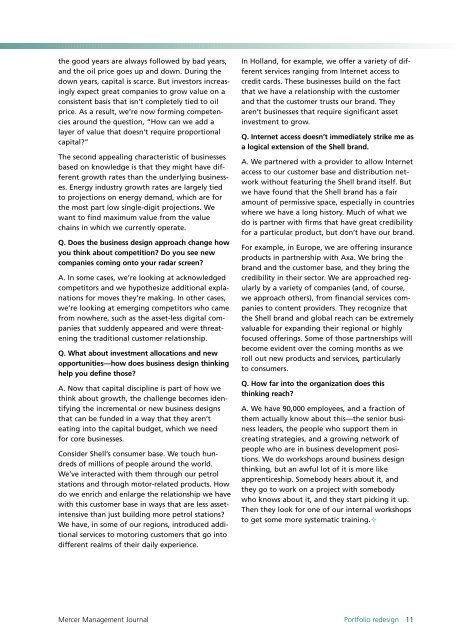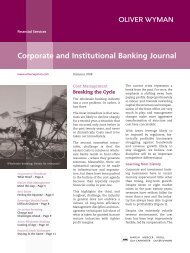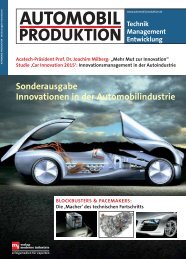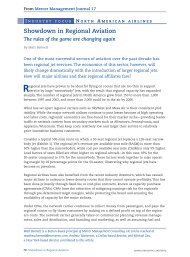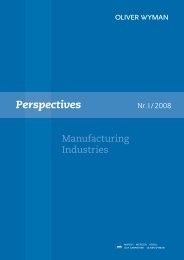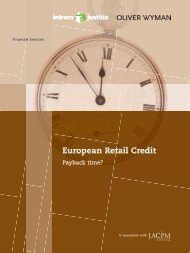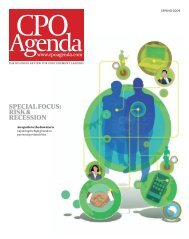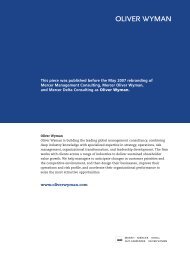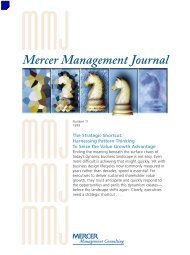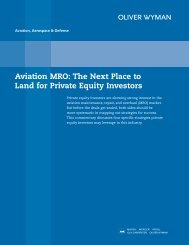Download the Report - Oliver Wyman
Download the Report - Oliver Wyman
Download the Report - Oliver Wyman
Create successful ePaper yourself
Turn your PDF publications into a flip-book with our unique Google optimized e-Paper software.
<strong>the</strong> good years are always followed by bad years,<br />
and <strong>the</strong> oil price goes up and down. During <strong>the</strong><br />
down years, capital is scarce. But investors increasingly<br />
expect great companies to grow value on a<br />
consistent basis that isn’t completely tied to oil<br />
price. As a result, we’re now forming competencies<br />
around <strong>the</strong> question, “How can we add a<br />
layer of value that doesn’t require proportional<br />
capital?”<br />
The second appealing characteristic of businesses<br />
based on knowledge is that <strong>the</strong>y might have different<br />
growth rates than <strong>the</strong> underlying businesses.<br />
Energy industry growth rates are largely tied<br />
to projections on energy demand, which are for<br />
<strong>the</strong> most part low single-digit projections. We<br />
want to find maximum value from <strong>the</strong> value<br />
chains in which we currently operate.<br />
Q. Does <strong>the</strong> business design approach change how<br />
you think about competition? Do you see new<br />
companies coming onto your radar screen?<br />
A. In some cases, we’re looking at acknowledged<br />
competitors and we hypo<strong>the</strong>size additional explanations<br />
for moves <strong>the</strong>y’re making. In o<strong>the</strong>r cases,<br />
we’re looking at emerging competitors who came<br />
from nowhere, such as <strong>the</strong> asset-less digital companies<br />
that suddenly appeared and were threatening<br />
<strong>the</strong> traditional customer relationship.<br />
Q. What about investment allocations and new<br />
opportunities—how does business design thinking<br />
help you define those?<br />
A. Now that capital discipline is part of how we<br />
think about growth, <strong>the</strong> challenge becomes identifying<br />
<strong>the</strong> incremental or new business designs<br />
that can be funded in a way that <strong>the</strong>y aren’t<br />
eating into <strong>the</strong> capital budget, which we need<br />
for core businesses.<br />
Consider Shell’s consumer base. We touch hundreds<br />
of millions of people around <strong>the</strong> world.<br />
We’ve interacted with <strong>the</strong>m through our petrol<br />
stations and through motor-related products. How<br />
do we enrich and enlarge <strong>the</strong> relationship we have<br />
with this customer base in ways that are less assetintensive<br />
than just building more petrol stations?<br />
We have, in some of our regions, introduced additional<br />
services to motoring customers that go into<br />
different realms of <strong>the</strong>ir daily experience.<br />
In Holland, for example, we offer a variety of different<br />
services ranging from Internet access to<br />
credit cards. These businesses build on <strong>the</strong> fact<br />
that we have a relationship with <strong>the</strong> customer<br />
and that <strong>the</strong> customer trusts our brand. They<br />
aren’t businesses that require significant asset<br />
investment to grow.<br />
Q. Internet access doesn’t immediately strike me as<br />
a logical extension of <strong>the</strong> Shell brand.<br />
A. We partnered with a provider to allow Internet<br />
access to our customer base and distribution network<br />
without featuring <strong>the</strong> Shell brand itself. But<br />
we have found that <strong>the</strong> Shell brand has a fair<br />
amount of permissive space, especially in countries<br />
where we have a long history. Much of what we<br />
do is partner with firms that have great credibility<br />
for a particular product, but don’t have our brand.<br />
For example, in Europe, we are offering insurance<br />
products in partnership with Axa. We bring <strong>the</strong><br />
brand and <strong>the</strong> customer base, and <strong>the</strong>y bring <strong>the</strong><br />
credibility in <strong>the</strong>ir sector. We are approached regularly<br />
by a variety of companies (and, of course,<br />
we approach o<strong>the</strong>rs), from financial services companies<br />
to content providers. They recognize that<br />
<strong>the</strong> Shell brand and global reach can be extremely<br />
valuable for expanding <strong>the</strong>ir regional or highly<br />
focused offerings. Some of those partnerships will<br />
become evident over <strong>the</strong> coming months as we<br />
roll out new products and services, particularly<br />
to consumers.<br />
Q. How far into <strong>the</strong> organization does this<br />
thinking reach?<br />
A. We have 90,000 employees, and a fraction of<br />
<strong>the</strong>m actually know about this—<strong>the</strong> senior business<br />
leaders, <strong>the</strong> people who support <strong>the</strong>m in<br />
creating strategies, and a growing network of<br />
people who are in business development positions.<br />
We do workshops around business design<br />
thinking, but an awful lot of it is more like<br />
apprenticeship. Somebody hears about it, and<br />
<strong>the</strong>y go to work on a project with somebody<br />
who knows about it, and <strong>the</strong>y start picking it up.<br />
Then <strong>the</strong>y look for one of our internal workshops<br />
to get some more systematic training.c<br />
Mercer Management Journal Portfolio redesign 11


